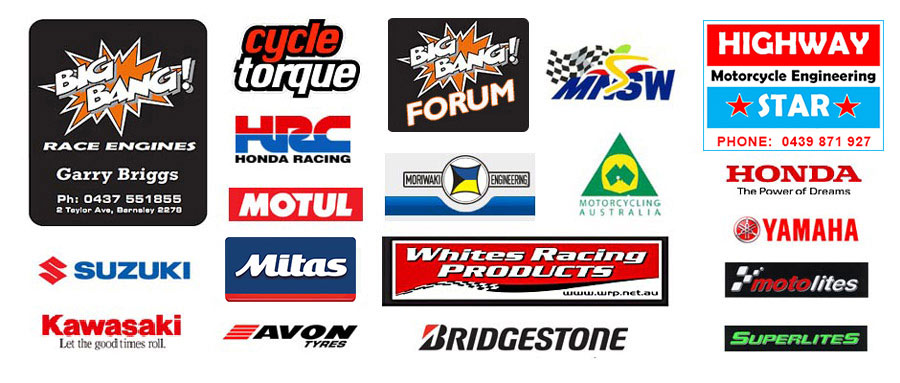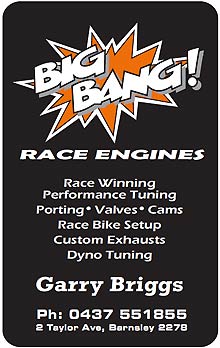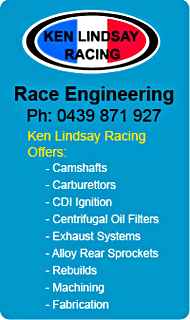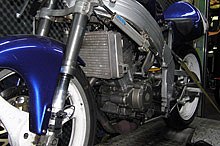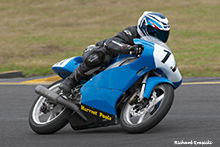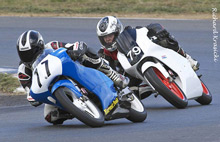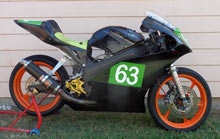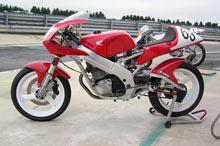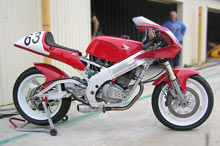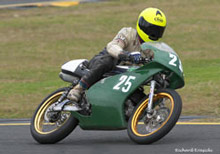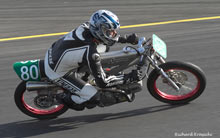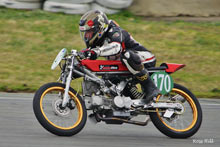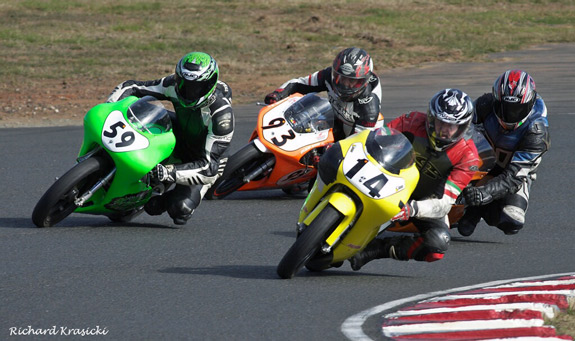
Four stroke leads two stroke! #14 KenLawrence (Honda RS CRF150R) and #59 Garry Briggs (BBR Honda RS CRF150R) both four stroke stalwarts lead two strokers Ron Carrick Yamaha YZ85) and #93 Paul Borg (Honda RS85cr) at an Eastern Creek meeting.
What are your equipment choices for a successful four stroke Motolite Race Bike?
So you've decided you've got the knowhow, resources and time to build a winning Motolite. Depending on how much work you intend to do yourself will dictate how much time you personally put into the project and have a bearing on the cost.
What chassis, engine, wheels etc to use, should it be two stroke or four stroke? The Motolite rules are pretty open except for capacity of four stokes being dictated by the valve count and whether water or air cooled.
For two strokes and for performance parity with the four strokes the capacity is 85cc for water-cooled and 111cc for air-cooled engines. (Two stroke options are covered in an article "Winning Motolite Details")
Motolite Capacity Rules
The performance parity of these different capacities and engine configurations have proven to be very close in performance and lap times creating competitive exciting racing for the Motolite class.
Engine capacities allowed in Motolite class:
- 85cc Water-cooled 2 stroke
- 111cc Air-cooled single cylinder 2 stroke
- 159cc Water-cooled 4 valve single cyl. 4 stroke
- 159cc Air-cooled 2 valve twin cylinder 4 stroke
- 175cc Air-cooled 3, 4 or 5 valve single cyl. 4 stroke
- 210cc Water-cooled 2 valve single cyl 4 stroke
- 190cc Air-cooled single cyl. Horizontal 4 Valve 4 speed gearbox (Laydown Motor)
- 230cc Air-cooled 2 valve single cylinder 4 stroke
These capacities are maximum sizes, a tolerance of 2% is included within these capacities. The Motolite class is open to any grade of rider.
The choice of engine to be used can dictate the chassis needed. We are only considering the four strokes in this article. The following list is by no means complete but covers engines readily available here in Australia.
Suitable Motolite Engines:
- 159cc Honda CBR150 water-cooled 4 valve single cyl. 6 Speed Gearbox
- 159cc Honda CRF150R water-cooled 4 valve single cyl. 5 speed Gearbox
- 159cc Yamaha FZR125 water-cooled 4 valve single cyl 6 speed gearbox (capacity increased to 159cc)
- 159cc Aprilia RSV125 water-cooled 4 valve single cyl 6 spd g.box (capacity increased to 159cc)
- 190cc Daytona Air-cooled single cyl. Horizontal 4 Valve 4 speed gearbox (Laydown Motor)
- 210cc 2 valve water-cooled 4 stroke
- 230cc Honda CRF230F Air-cooled 2 valve single cylinder 6 speed Gearbox
- 230cc Crossfire (Zongshen) CF230 Air-cooled 2 valve single cylinder 5 speed Gearbox
Suitable Rolling Chassis
Suitable chassis for the above list of motors can be almost anything, but using one that works is the trick for success. For a decent rolling chassis you can't go past the Honda RS125 GP bike for it's handling and light weight. This would be the ultimate solution as suspension, brakes, weight and handling are all sorted and full attention can be applied to the motor and fitting.
However it may not suit all the motors listed for instance getting the 230cc engines to fit is a bit of an engineering feat but it can be done. Trevor Lusby won a Motolite championship in the not so distant past with RS GP running gear wrapped around one of these engines albeit in 185cc form as the rules dictated at the time. Also with the four stroke engines the later RS125 chassis with vertical rear suspension unit has to be used as the horizontal rear suspension unit in the earlier chassis gets in the way of the taller four stroke engines which means they won't fit. The two stroke motors fit in the earlier frame as it was designed for these engines in the first place.
CBR150 and CRF150R Engines
The CBR150 and CRF 150R motors sit well in the later Honda RS125 GP Chassis. Motolite race bikes with either of these engines have had great success in the past winning the one hour enduro many times and countless Motolite Championships.
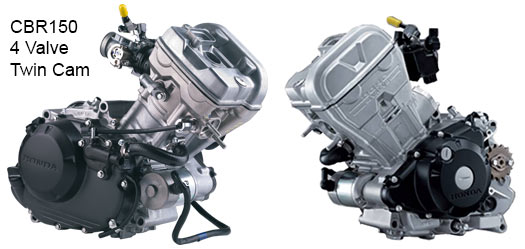
Honda CBR150 Motor 150cc 4 valve twin cam water-cooled 6speed gearbox.
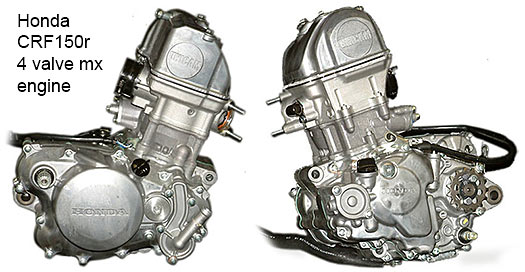
Honda CRF150R mx motor 4valve Unicam water-cooled 5 speed gearbox
Which of these two engines to choose would boil down to availability. There is little or no difference in performance that is after they have been modified. These bikes have proved a match for the Honda RS85cr GP framed bikes with the right rider on board.
The CBR150 engine can also be used in it's own frame or in the CBR125 frame, wider rim wheels would be advantageous but not essential if it's delaying your debut.
Michael McLean ran a bog standard CBR150 to great effect for a few years and had a lot of fun doing so.
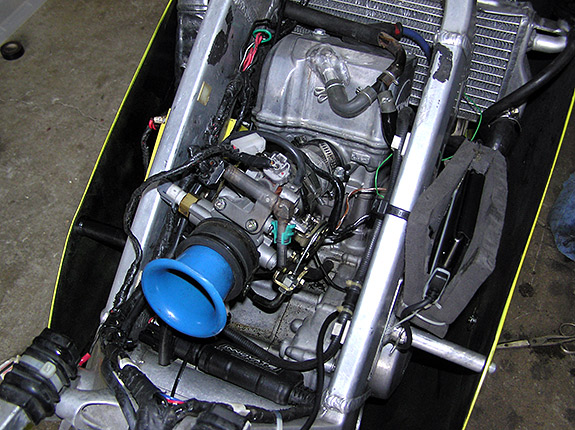
Fuel injection is also an avenue that can be explored as seen here in Ken Lawrence's Motolite which runs the CRF150R motor. However this is the exception to the rule, the carbies still rules usually flat slide Keihins or Mikunis.
Yamaha YFZR and Aprilia RS4
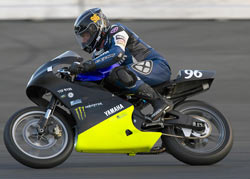 For the Yamaha and Aprilia 159s these are
originally 125s with the capacity taken out to the
maximum 159cc. Usually these engines are used with
their original frames and running gear as they are
sold as reasonably well appointed sports bikes.
Being over the counter road bikes they will be a bit
heavier than an RS based machines but can still be an
very effective racer. The challenge is to shed as
much weight as possible.
For the Yamaha and Aprilia 159s these are
originally 125s with the capacity taken out to the
maximum 159cc. Usually these engines are used with
their original frames and running gear as they are
sold as reasonably well appointed sports bikes.
Being over the counter road bikes they will be a bit
heavier than an RS based machines but can still be an
very effective racer. The challenge is to shed as
much weight as possible.
Right: Jeff Brown hustles his much modified Yamaha YFZ150 along to good effect.
230cc Honda CRF230F
230cc Crossfire CF230 (Zongshen)
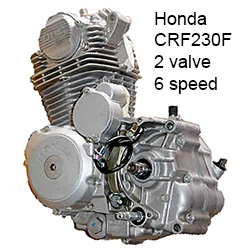
The only real difference between these 2 motors is the Honda has a six speed gearbox whilst the Crossfire engine has a five speed. No real drama for the five speed as these engines have a abundance of mid range torque and a six speeder seems almost superfluous. They share the same bore and stroke (65.5 x 66.2mm) with a lot of the parts being interchangeable. There is plenty tuning bits available for these engines and they can be made to go quite well. Again talk to the tuners advertising on this website.
The Crossfire
engine sells for around $640.00 brand new.
At this price it
leaves plenty of room for spending on go faster gear. With both
engines they would have to be modified, cam,
head work, exhaust and larger carburettor would be
the norm to get to the pointy end. Fuel injection is
also an option. Weight wise these
engines would be several kilos heavier than the 85cc
two strokes but would go some way to make up for it
with their meatier torque curve.
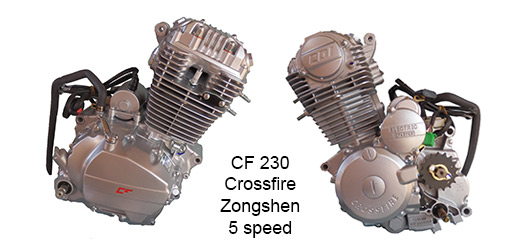
What chassis to use?
As mentioned earlier these engines can be a bit of a squeeze to get into a Honda RS125 chassis, it can be done but it would be best to check with any of the people advertising on the website as they have done this previously.
Currently a Honda 210 cc engines is running in a Suzuki RGV250 chassis the ex Bob Murphy bike now in the capable hands of Clark Russell. Another alternative chassis choice would be to slot one of these engines into CBR125/150 frame which can be picked up quite cheaply. Wider rims than standard CBR125s would probably be desirable. There may be other frames suitable read Aprilia Yamaha FZR125/250 KTM125 but these haven't been tried.
Supermono 190
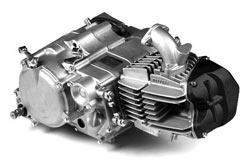 For the other engines the 190cc Daytona engine
powered Supermono's have been having success
finishing second in the first round of the 2016 Sava
Tyres Bucket Nationals at the South Circuit at
Eastern creek and being regular visitors on the
podium.
For the other engines the 190cc Daytona engine
powered Supermono's have been having success
finishing second in the first round of the 2016 Sava
Tyres Bucket Nationals at the South Circuit at
Eastern creek and being regular visitors on the
podium.
When the Supermono is purchased it comes with a basic Chinese 150cc motor which is uncompetitive although it's quick enough to get some race miles under your belt. The complete Supermono with 150cc engine will set you back a mere $1990.00 ready to go. Contact Nigel Begg on 0452 433 523.
To make this little gem (Supermono) competitive you will would need to purchase the Daytona Anima 190 four valve engine, it bolts straight into the Supermono frame. Whilst out of the box this engine is a lively performer, to be really competitive in this class and as with the other engines covered above the Daytona engine needs a tuners touch to be seriously competitive.
You can sell the 150cc motor on to offset some of the costs of buying the bigger engine.
The Daytona 190 air cooled motor has a horizontal layout with four speed gearbox, four valve head with roller rocker arms and bore 62mm x stroke 62mm. The motor sells for $1399.00. Download Engine user manual for full specs.
This engine could also be a candidate to slip into a Honda RS125 GP chassis.
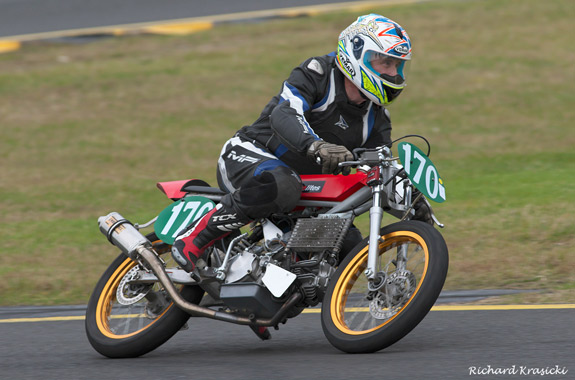
Michael Child aboard the Supermono190 finished second in the first round of the 2016 Sava Tyres Bucket Nationals at the South Circuit at Eastern creek..
So there you have it!
This was just a run through some of the possible combinations of engine and chassis available for four stroke use in the Motolite class, you may have other ideas of a winning combination. Don't just keep keep thinking about it DO IT!
If your budget is tight we would suggest get your bike built and ready for the track before spending up on engine modifications. All of the above engines have good performance standard out of the box and would get you into the fray immediately. With a few races under your belt and some experience of what is required then turn your attention to getting more out of your package.
Cheers see you at the track!
LUSBY WORKS
Honda RS125 RS250
& CR85
Parts and Race Preparation
Call Trevor on
0415 884 838
BRA Champions
Motolites
- 2017 Jason Dunn(Honda RS85CR)
- 2016 Jason Dunn(Honda RS85CR)
- 2015 Jason Dunn(Honda RS85CR)
- 2014 Tyler Bradford(BBR CBR150)
- 2013 Jason Dunn (Honda RS85CR)
- 2012 Paul Borg (Honda RS85CR)
- 2011 Jason Dunn (Honda RS85CR)
- 2010 Michael Carruthers (RS85CR)
- 2009 Paul Borg (Honda RS85CR)
- 2008 Garry Briggs (RS150CBR)
- 2007 Trevor Lusby (Jianshe 185)
- 2006 Garry Briggs (RS150CBR)
- 2005 Garry Briggs (RS150CBR)
- 2004 Lindsay McKay
Superlite Pro
- 2017 Walter Murphy (Honda CB185)
- 2016 Tim Smith (Honda CB150)
- 2015 Ian Gregory (Honda CB150)
- 2014 Walter Murphy (Honda CB150)
- 2013 Walter Murphy (Honda CB150)
- 2012 Fred Holland (Honda CB150)
- 2011 Ken Lindsay (Honda RCB150)
- 2010 Jeff Clissold (Honda CB150)
- 2009 Jeff Clissold (Honda CB150)
- 2008 Ken Lindsay (Honda RCB150)
- 2007 Phillip Favero (Honda CB150)
- 2006 Ken Lindsay (Honda RCB150)
- 2005 Bruce Edwards (Honda CB150)
- 2004 David Phillips (Honda CB150)
- 2003 Garry Briggs (Honda CB150)
- 2002 Garry Briggs (Honda CB150)
Superlite AM
- 2017 Shaun Bray (Suzuki GS150)
- 2016 Stuart Ellis (Suzuki GS150)
- 2015 Hermann Wagus (Honda CB150)
- 2014 Robert Tisdell (Honda CB150)
- 2013 Ryan Phillips (Honda CB150)
- 2012 Jim Murphy (Honda XL150)
- 2011 Adam Muldoon(Honda CB150)
- 2010 Walter Murphy (Honda CB150)
- 2009 Tim Smith (Honda CB150)
- 2008 Lyall Kumera-Cairns
- 2007 Martin Kraaymaat(CB150T)
- 2006 Martin Kraaymaat (CB150T)
- 2005 Martin Kraaymaat (CB150T)
- 2004 Michael Moore (Honda CB150)
- 2003 Phil Favero (Honda CB150)
- 2002 Kyle Chick (Honda CB150)
Commuterlite Pro
- 2017 Keo Watson (Honda CBR125)
- 2016 Keo Watson (Honda CBR125)
- 2015 Nicholas Miller (Honda CBR125)
- 2014 Ron Pulido (Honda CBR125)
- 2013 Anthony Marsden (CBR125)
- 2012 Ryan Young (Honda CBR125)
- 2011 Ron Carrick (Honda CBR125)
Commuterlite AM
- 2017 Gregory Burt (CBR125)
- 2016 Luke Rhodes (CBR125)
- 2015 Rez Pulido (CBR125)
- 2014 Adam Cameron (CBR125)
2stk Superlite Pro
- 2005 Greg Gould
- 2004 Greg Gould
- 2003 J. Wright
- 2002 Russel Barker
2stk Superlite AM
- 2005 Clinton Edwards
- 2004 Peter Wade
- 2003 Stefano Montressor
- 2002 Michael Combley
